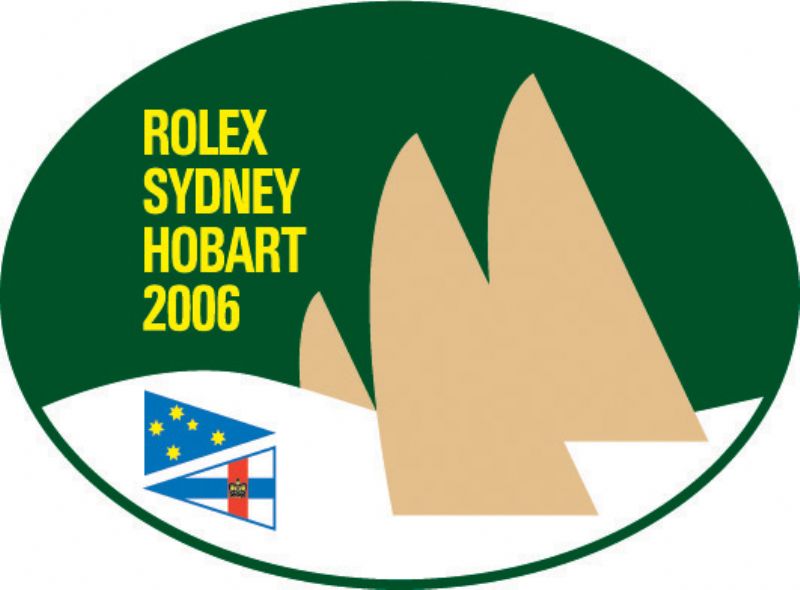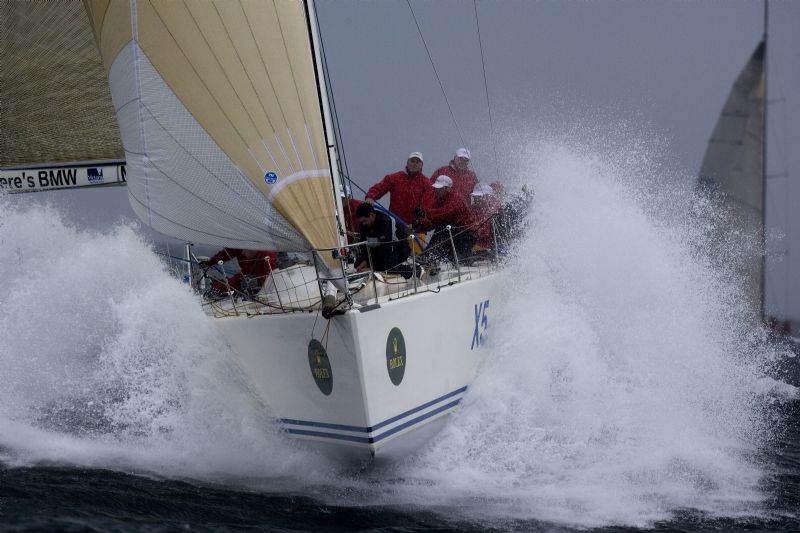New Reichel Pugh boats set
for intense fight: tough competition looms for new 55 and 60 footers
The line-up for the 2006
Rolex Sydney Hobart dropped to 79 today after Ludde Ingvall's 90ft maxi
Diabetes was dismasted during a training sail. While sailing under reefed
main and jib in 16-17 knot easterly winds off Sydney Heads, the mast
appeared to compress causing it to buckle and fall overboard, said a
disappointed Ingvall, a two time line honors winner of the Sydney Hobart
race. To prevent further damage the mast was cut away and, with just six
days left to go before the Boxing Day start, there seems little chance of
Ingvall finding a replacement spar.
 |
Next week, while the 98 footers
slog it out for line honors glory at the front of the Rolex Sydney Hobart
race fleet, a few miles astern of them a heated competition will be taking
place among the 50 to 60 footers.
There, going head to head, will
be two of the newest boats in this year's Rolex Sydney Hobart: Stephen
Ainsworth's Loki, launched in June 2005, finished third in class and
seventh overall last year; Geoff Ross' latest Yendys is brand new.
Both boats were designed by San Diego-based naval architects Reichel/Pugh -
also responsible for Wild Oats XI, last year's Rolex Sydney Hobart
line honors and handicap winner, and race record setter. But while Loki
is a 60ft racer cruiser, Yendys is a 55ft full-on race boat, and as
an indication of what is expected in this year's Boxing Day run south, the
two boats finished last week's Rolex Trophy Series in Sydney Harbor
separated by just 0.1 point on handicap, Loki ahead by a whisker.
The Rolex Trophy Series indicated
that the two boats are suited to different conditions. Yendys has
been designed and built to be a competitive racing yacht offshore under IRC,
and according to owner Ross her builders in China put as much structure into
her as they would a maxi boat. She would seem to be the faster boat if the
going gets tough, while Loki is better in light conditions. As Loki's
Stephen Ainsworth puts it : "They (Yendys) won three out of the four
races in the first two days when it was 20 knots plus and we won three out
of the four races on the last two days when it was below 20 knots."
 |
| Loki sailing the Rolex Sydney Hobart race. Photo by: Carlo Borlenghi/ Rolex |
Loki has the advantage of
her crew having put many miles under her keel in the last 18 months - aside
from winning the Rolex Trophy Series, they also were first in the recent
Savills Regatta here in Australia and were second in the big boat class at
Hahn Premium Race Week at Hamilton Island in August. Her crew includes
former Etchells world champion Cameron Miles and Volvo Ocean Race veteran
Tom Braidwood. But Yendys is coming on line fast and has much more
speed potential to eke out and a crew bristling with Volvo Ocean Race
talent, including Noel Drennan and Pete Doriean.
Geoff Ross had the new Yendys
built when the Tattersall's Cup, the main handicap trophy for the Rolex
Sydney Hobart, was changed to be raced under IRC rather than IMS. Typically
the race has been won by 45 - 50 footers, says Ross. The new Yendys
is a little larger and is simple but powerful - she has no canting keel, no
running backstays, no overlapping jib, but a massive sail plan.
 |
| Flirt sailing the Rolex Sydney Hobart race. Photo by: Carlo Borlenghi/ Rolex. |
The handicap winner in the Rolex
Sydney Hobart will be partly decided by the weather conditions, but on a
more level playing field the two newest boats in the fleet would be ones to
watch. As Geoff Ross puts it: "On the ocean every dog has its day. A
Beneteau 40.7 could clean us all up - that has happened and there's nothing
you can do about that. If we are all in the same conditions then there is a
bunch of good boats in Divisions 1 and 2: Flirt (Chris Dare's Corby
49), the canting keel Cookson 50 Quantum Racing, the Nelson Marek 52 (Graeme
Wood's Wot Yot) - there are a bunch of good boats, all of which will
be well-sailed."
This morning, six days out from
the start, Barry Hanstrum, Regional Director, NSW of Australian Bureau of
Meteorology, gave his long term forecast for this year's race. Hanstrum was
at pains to point out that this was at the outer limit of reliable
predictability. The Australian Bureau of Meteorology forecasted that as of
the 26 December start, there will be southerly winds between a low pressure
system in the Tasman Sea (between Australia and New Zealand) and a high
pressure over the Australian Bight.
"At this range there are a couple
of scenarios," said Hanstrum. "One is that the low will be far enough
offshore in which case the wind would be a stiff southerly and conditions
would be rough. That is the most likely scenario but it is still possible at
this range that the low pressure system is closer to the New South Wales
coast; if that unfolds there would be a period of gale force winds for the
start of the race."
If this forecast proves true it
will mean the 80 strong Rolex Sydney Hobart fleet will find themselves not
only punching into headwinds, but also a dangerous seaway where the
southerly wind counters the 2-3 knot south flowing East Australian Coast
Current. As Wild Oats XI navigator Adrienne Cahalan puts it: "That is
boat-breaking stuff because the seas lose their backs. No boats like that."
 |
| Wild Oats XI sailing the Rolex Sydney Hobart race. Photo by: Carlo Borlenghi/ Rolex. |
While the timing of this forecast
will be tightened up closer to the start, what is more certain is that the
weather will improve. Hanstrum continues: "After the low develops and
depending upon where that happens it will move away to New Zealand over the
next day allowing the high pressure that is in the Bight to move further
eastward. That will cause a lightening of the winds over the ensuing days as
the course comes more under the influence of the ridge of high pressure than
the winds around the low pressure system."
Running south from Sydney the
boats must pass the eastern entrance to Bass Strait, between Tasmania and
the Australian mainland, and it is weather funneling through the Strait
combined with the strong south flowing current that makes the Rolex Sydney
Hobart race course one of the most complex and treacherous. In a race where
bad weather can cost lives, as it did in 1998, accurate weather forecasting
is vital. Fortunately, says Hanstrum, their tools for creating forecasts
have dramatically improved since the race eight years ago when six
competitors lost their lives and 55 were rescued due to the severe weather.
"The forecast on the third day of the three day forecast is now about as
good as the one day forecast 10 years ago. The main reason for that
improvement is that satellites around the globe are providing a huge amount
of extra information in defining and analyzing what the current weather
situation is globally. Thanks to that we have a much better chance of making
a good forecast."
Full list of nominated yachts
available from:
www.rolexsydneyhobart.com
All contents are copyright (c) 2006 by
Northern Breezes, Inc. All information contained within is deemed reliable
but carries no guarantees. Reproduction of any part or whole of this
publication in any form by mechanical or electronic means, including
information retrieval is prohibited except by consent of the publisher.